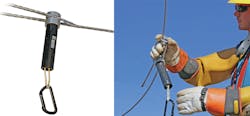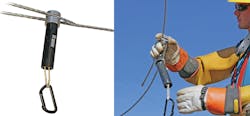Lineman Invents Clamp to Control Conductors
Linemen must maintain positive control of the loose ends of conductor at all times, according to the Occupational Safety and Health Administration. Conductors, however, often have a mind of their own. Even when uncoiled from a reel, they can snap back into shape. In turn, the loose end of a conductor can whip around violently, creating a hazardous work area.
For example, while observing his line crew cut hot jumpers, Kevin Grinstead noticed that his linemen were at risk of getting struck by the loose end of a conductor. At that moment, he decided he wanted to find a better and safer way to perform the task, and he went to work on his invention.
Grinstead, a line crew leader for a utility in western Ohio for the last 16 years, designed a prototype at home using a hot line clamp and threaded rod. He eventually traveled to North Carolina to present his idea to Utility Solutions, which made several modifications.
Refining the Invention
After Grinstead demonstrated his idea to Utility Solutions, the company saw that it met a need in the marketplace, and it began working on prototypes. Peter Shirilla, a mechanical engineer for Utility Solutions, worked with other engineers to design and test several different prototypes. The engineering team then decided which features worked well and what needed improvement. For example, Shirilla says one of his favorite features is the quick-release trigger, which saves time in the field. For example, linemen must turn a knob when tightening the head on a temporary jumper, but the ratcheting head of the quick-release trigger greatly reduces the time necessary to fasten a conductor securely.
Through the invention process and a collaborative effort, the tool evolved through many different prototypes. Today, Grinstead’s product, the Tail Tamer, features an easy-grip barrel, weighs only 1.5 lb and is patent-pending. Unlike the original prototype, which had only one function, the re-engineered product is a four-in-one hot line clamp rated for amperage.
“Our linemen helped me to design the first prototype, and now we have the Utility Solutions tool on all of our bucket trucks,” Grinstead says.
Securing Loose Ends
The Tail Tamer now serves many functions, but it was originally designed to hold back the loose ends when linemen are stringing new line or replacing a conductor.
If they terminate one end to the dead end and get it properly tensioned, they often leave several feet of cable after the termination — called the tail. To ensure that the tail won’t flop around loosely, many linemen use electrical tape to hold it under control.
After cutting the conductor, they must bend it back and tape it up, which is easy for two linemen, but not for a lineman working solo. It can also be unsafe if the conductor makes contact, causing a flash. By using the Tail Tamer, however, a lineman can place both ends together, control the conductor, and not worry about one of the ends coming loose or dropping down into an energized transformer bank.
Serving Other Functions
In addition to holding the loose end of a conductor, the Tail Tamer can serve as a temporary parallel groove connector rated at 300 A. For example, Grinstead says his crews used the tool for that function not long ago while putting a slack span on an overhead single phase. When removing a piece of URD primary underground conductor, the linemen attached the Tail Tamer on both ends of the slack span, disconnected the underground wire and pulled it out, and then installed a new piece of primary. "It works pretty well when you have a section of wire that you want to get rid of or replace, and you need a temporary connection," Grinstead says.
Linemen also can use the Tail Tamer when cutting a slack conductor with up to 200 lb of tension. By simply adding two Tail Tamer clamps to the line and using the included high-strength carabiners, a lineman can cut the line between the tools and maintain positive control over both loose ends.
Finally, linemen can use the double-sided clamp to hold two conductors simultaneously, and then they can attach parallel groove, crimp or wedge connectors. At Grinstead’s Ohio-based utility, linemen have used the clamp to send a Hendrix wire on a hand line when cutting jumpers.
The high-strength tether and carabiner can connect to each other, to buckets or to belts, and they can either work as a single unit or in pairs. For example, Grinstead says his linemen have used the clamps together for pulling wire in for temporary connections.
By designing the tool, Grinstead and Utility Solutions have helped linemen to overcome an obstacle in the field, improve the safety of their line crews and save labor. The product, which won the 2017 Best of the Best award at the International Lineman’s Expo, is available to crews nationwide.
“It was a fun product to work on, and I like the way it turned out,” Shirilla says. ♦
Check out the March 2018 issue for more articles, news and commentary.
About the Author
Amy Fischbach
Electric Utilities Operations
Amy Fischbach is the Field Editor for T&D World magazine and manages the Electric Utility Operations section. She is the host of the Line Life Podcast, which celebrates the grit, courage and inspirational teamwork of the line trade. She also works on the annual Lineworker Supplement and the Vegetation Management Supplement as well as the Lineman Life and Lineman's Rodeo News enewsletters. Amy also covers events such as the Trees & Utilities conference and the International Lineman's Rodeo. She is the past president of the ASBPE Educational Foundation and ASBPE and earned her bachelor's and master's degrees in journalism from Kansas State University. She can be reached at [email protected].


